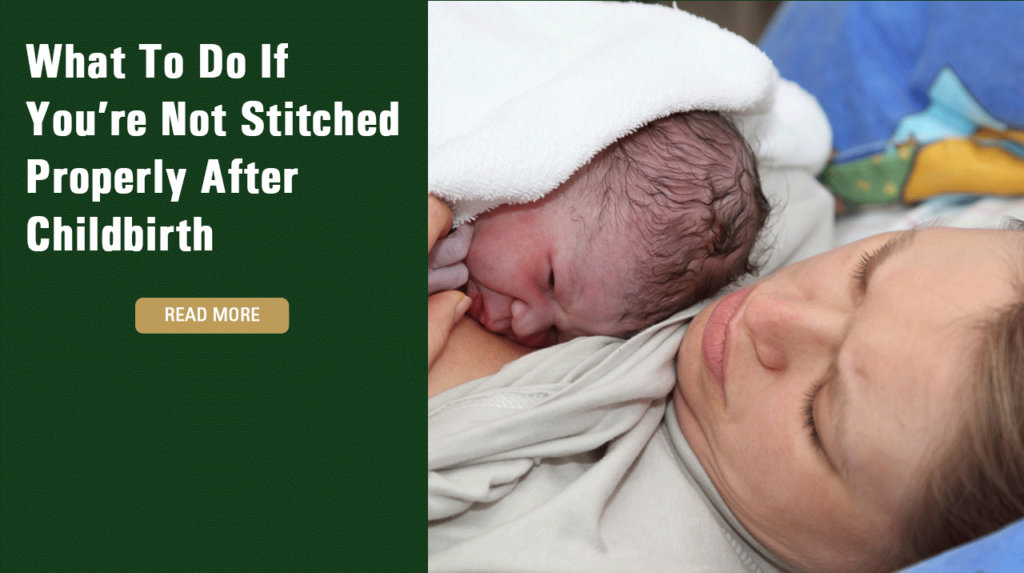What To Do If You’re Not Stitched Properly After Childbirth

During labor and delivery, it is common for women to experience tears in the vagina and perineum, which is the area between the vagina and anus. In some cases, women might also suffer tears in their cervix caused by the pressure of the baby’s head as the baby moves through the birth canal. A majority of women experience at least small tears from childbirth. Tears can vary in severity, and more severe tears will require stitches. Unfortunately, however, additional problems can be caused if your stitches were improperly done. Similarly, you might suffer complications if the doctor didn’t stitch you. Here is how to tell whether you were improperly stitched following childbirth from the attorneys at Raynes & Lawn.
Perineal Tears
Perineal tears can happen during a vaginal delivery because of stretching of the perineum as the baby emerges.
While tears are common, they vary in severity as follows:
- First-degree perineal tear – Least severe and involves a small tear of the skin of the perineum
- Second-degree perineal tear – Most common and involves a tear that is slightly deeper and extends to the muscle and skin of the perineum
- Third-degree perineal tear – Occurs when the tear extends into the muscles from the vagina back to the anus
- Fourth-degree perineal tear – Most severe tear that extends to the anal sphincter and the rectum
Most tears will require sutures or stitches, although some will not. Stitches are also used if you had an episiotomy. If the stitches are not properly done, the area can fail to heal and lead to pain and infection.
What Happens If You Don’t Get Stitches After Birth?
If your doctor failed to identify a tear and didn’t stitch you, the tear will not heal properly. You could develop an infection and other problems. Failing to identify a tear or to stitch it could be medical malpractice.
How Long Does It Take To Heal From A Perineal Tear?
You can expect to experience discomfort for several weeks after giving birth. However, the pain should lessen each day and be the most painful during the first week. It will take a longer period to heal from a more severe tear that involves the muscles. You’ll need to make sure to clean the area to aid the healing process. However, if the doctor did not stitch you properly, the tear won’t properly heal and might result in an infection.

Stitches Following Birth
Doctors typically use self-dissolving sutures to repair perineal and vaginal tears. Severe tears require more stitches, and medical providers should identify tears that occur during delivery. In most cases, doctors will repair tears in the hospital room after the woman gives birth, but severe tears might require stitching in an operating room. When doctors fail to identify tears or improperly stitch them, resulting in harm, their actions might rise to the level of medical malpractice.
Signs To Watch For
It’s common to feel discomfort from your stitches following birth. However, if the pain does not lessen, or you experience other symptoms, you might have been improperly stitched. Here are some of the signs of improper stitching.
Foul Odors
Unpleasant odors following vaginal delivery can indicate you have an infection. Make sure to clean the stitched area regularly and check for discharge and odors. If you have a foul-smelling discharge or discharge that is pus-like, the tear could be infected.
Ongoing Pain
You might experience pain for several weeks after giving birth from your stitches. However, if the pain doesn’t gradually lessen following the first week, it could indicate improper stitching and an infection.
Inflammation
If your perineum is inflamed and red, that can be an indicator of infection. Look for swelling and excessive redness in the area, and call your doctor if you notice these problems.
Gaps In Stitches
If there are gaps in your stitches, this can indicate improper stitching. You can use a mirror to look at the suture line to see if anything looks abnormal. You might also feel gaps when you clean the stitched area.
Fever
If you develop a fever, it is an indicator that you might have an infection from stitches and your tear not healing correctly. Take your temperature every day to watch for fever.
Fecal Incontinence
If you have a third- or fourth-degree tear, your rectum and anal sphincter muscles might have been affected. If your doctor did not properly stitch the tear, you could have fecal incontinence. If you have experienced any of these symptoms, you should speak to your doctor immediately to identify the issue and obtain proper treatment. You might have to have your stitches removed and be prescribed antibiotics. You might also need restitching.
Antibiotics are normally prescribed when an infection is discovered. If you are prescribed antibiotics, ask your doctor about any concerns you might have about nursing your baby while taking your medication. Restitching might also be necessary if your tear is not properly healing or if it is more severe than the doctor initially believed.
Consult An Attorney
If you think that you were improperly stitched following birth, you should speak to a lawyer at Raynes & Lawn. Improper stitching can result in complications that can continue to affect you in the future. Call Raynes & Lawn today at 1-800-535-1797 to request a free consultation so that you can learn more about the legal remedies that might be available.

For the general public: This Blog/Website is made available by the law firm publisher, Raynes & Lawn, for educational purposes. It provides general information and a general understanding of the law but does not provide specific legal advice. By using this site, commenting on posts, or sending inquiries through the site or contact email, you confirm that there is no attorney-client relationship between you and the Blog/Website publisher. The Blog/Website should not be used as a substitute for competent legal advice from a licensed attorney in your jurisdiction.
For attorneys: This Blog/Website is informational in nature and is not a substitute for legal research or a consultation on specific matters pertaining to your clients. Due to the dynamic nature of legal doctrines, what might be accurate one day may be inaccurate the next. As such, the contents of this blog must not be relied upon as a basis for arguments to a court or for your advice to clients without, again, further research or a consultation with our professionals.
